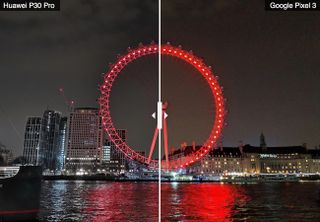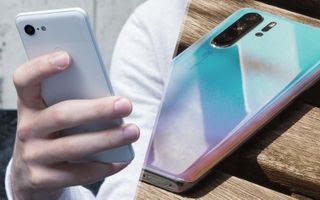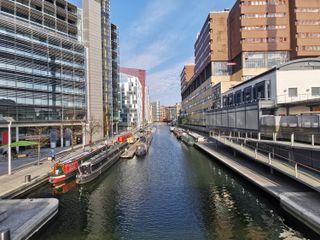Huawei P30 Pro vs. Pixel 3 Camera Shootout: Google Just Got Beat
While the choice between these phone cameras sometimes comes down to personal preference, the Huawei P30 Pro shows much more potential for capturing amazing nighttime photos than the Pixel 3.

Ask, "What's the best camera phone?" and the default answer since last fall has been Google's Pixel 3. But as the Pixel 3's software and hardware ages and new contenders enter the market, the answer to that question may change — and sooner than you may think.

Huawei's P30 Pro, the Chinese phone maker's latest photography-focused flagship device, brings a lot of potential to the table. While it suffers from a lack of availability in the U.S., the 128GB version of the P30 Pro costs only a little more than the 128GB version of the Pixel 3 (£899 compared to £839, or roughly $1,173 to $1,095).
To see which phone took the better pictures in a variety of circumstances, we had a multi-day face-off between the P30 Pro and Pixel 3. First, we went out in London after dark to see how the respective phones fared in low-light situations. Then, we followed up in daylight where put features like portrait mode and zoom to the test.
Here’s how the two phones fare and whether Google has any reason to be nervous about its camera phone crown.
Camera specs: How the Huawei P30 and Pixel 3 compare
The camera on the Pixel 3 features a single 12-megapixel sensor. The P30 Pro offers a trio of lenses — 40-MP main, 20-MP ultrawide and 8-MP telephoto sensors — plus a time-of-flight sensor for measuring the depth of an image's subject. Significantly, the P30 Pro's main camera uses a world-first RYYB sensor instead of an RGGB one, which Huawei says contributes to the phone's ability to capture plenty of light.
In the interest of testing the phones fairly, I shot all images at the best 4:3 resolution they could produce, which meant 12 MP for the Pixel and 10 MP for the P30 Pro. You can also shoot images in 16:9 on the Pixel or 1:1 or full screen on the P30 Pro.
MORE: Galaxy S10 vs Pixel 3 Camera Shootout: Which Phone Wins?
While I stuck to using the main rear cameras for this face-off, it's worth pointing out that the P30 Pro's night mode is not available on the phone's 32-MP selfie camera, while the Pixel does offer this feature. On the other hand, the P30 can use any of its three rear cameras with night mode, so you can use the phone's wide-angle lens or its particularly impressive zoom capabilities at the same time.
P30 vs. Pixel 3: Which is better at night?
What does all that hardware mean in terms of performance at night? To find out, we compared the Huawei P30 Pro to the Pixel 3 in a half-dozen different shooting situations.
Huawei approaches night mode by taking pictures with very long exposure times, around 4 to 6 seconds, plus a lower ISO to compensate for the extra light that results from that method. The Pixel 3 also lowers the ISO and increases its exposure time, but only to about a quarter to a third of a second.
London Eye: In our first test, we checked how much detail of the famous observation wheel the two phones could capture. The P30 Pro shows an impressive amount of the thin spokes on the wheel's interior, as well as detail around the wheel's circumference, keeping the light sources in check.
There isn't a huge amount of difference between the Pixel 3's auto and Night Sight modes, save for the brightness level. I prefer the auto-mode picture in this case, but it still can't defeat either image the P30 Pro produced.
Winner: Huawei P30 Pro
Street lamp: So, how do the phones deal with closer, bright objects set against a dark background? It's a similar story as before: The P30 Pro is able to control the light far more effectively than the Pixel, especially in night mode, where you can clearly make out the lamp's metal casing.
Google's phone can't match this at all, with the light flooding out all but the largest part of the frame. Swapping between auto and night mode doesn't change much, although night mode does at least brighten up the buildings behind to give some background texture. But since the Pixel performs so poorly with the main subject of this photo, the victor here is obvious.
Winner: Huawei P30 Pro
Houses of Parliament: Shooting the Palace of Westminster from midway along Westminster Bridge offers further proof of the difference in quality of the auto modes on these phones. The farthest side of the building becomes almost a silhouette on the Pixel 3's picture, but with the P30 Pro, you can discern the windows and lines of the palace's walls all the way to the end, thanks to the proprietary sensor in Huawei's phone.
With night mode active, the Pixel 3 has a brighter image, benefitting from a greater number of weaker light sources illuminating the subject. The P30 Pro is just as sharp but with less light and deals effectively with the strong light coming from the right-hand side of the image. On balance, though, I would say this is the first image where I prefer the Pixel 3's offering to the P30's.
Winner: Google Pixel 3
Waterloo Station: The test here involves a mid-distance object with a mix of well-it and shadowy areas. The difference between auto and night mode on the P30 Pro is fairly subtle, but noticeable. The darker stonework above the arch, the lettering within it, the stone figures and the clock, which are all sharper with the night mode enabled.
Winner: Huawei P30 Pro
Wall art: Indoors, in pitch darkness is where the P30 Pro shines the brightest. The Pixel 3 struggles to capture anything except the darkness and gets only a fuzzy image when night mode is active. In contrast, the P30 Pro doesn't break a sweat, essentially offering you two different filters of the same image, which has enough fidelity to show you the dewdrops on the petals of the flower.
I don't imagine it's going to be a regular use case for smartphone photographers, but if you happen to need a way of taking candid pictures somewhere with little to no light, or if you just want to show off to people with inferior smartphone cameras, then the P30 is unmatched.
Winner: Huawei P30 Pro
Night sky: It's hard to find a very dark place outside when you live in one of the best-lit areas of the country. All the same, pointing the phones up at the sky shows how well the P30 Pro can work with a very dark background.
Winner: Huawei P30 Pro
P30 vs. Pixel 3: Which is better during the day?
So with the P30 Pro coming out decisively as the victor in the night-time stage, how do the two phones compare when the sun is out? We hit the streets during daylight to see how the two cameras stacked up.
Paddington Basin: These shots, taken from a bridge looking over the end of the Regent’s Canal’s Paddington arm, are full of interesting details, from the bright sky to the water to the reflections in the buildings that surround the area. The long open space also provides a challenge in capturing an image’s depth.

The P30 Pro gets to show off its ultra-wide angle lens here, showing a little more detail at the sides and accentuating the distance impressively.
In shot-vs-shot comparisons, you can see how the P30 Pro offers superior details throughout the image, from the smaller ripples in the water to the clarity of the clouds in the background. However, the way the extra light interacts with the shiny surfaces of the buildings makes the image look a little washed out. While the Pixel is less detailed, its image gives a better contrast between the lighter and darker elements of what it captured. It’s a tough call, but the Pixel just edges out the P30 Pro.
Winner: Pixel 3
Statue: This sculpture outside St. Mary’s Hospital has a dark but also slightly reflective surface that you can easily get close to, making it a challenge to capture details from a short range.
The P30 Pro produces a brighter shot, but in doing so, some of the subtler lines and marks in the statue are downplayed. The Pixel 3 provides the opposite: a darker shot overall but one that more capably shows off the unique shape of this piece of art.
Winner: Pixel 3
Portrait: With Rembrandt Gardens in Little Venice as my backdrop and a friendly assistant to take the pictures for me, we can see how well the phones deal with portrait-style photos, both normally and with their bokeh-enhanced portrait modes enabled.
The P30’s image could fool you into thinking these pictures were taken on a sunny day. The entire photo — from the foliage in the background to my skin color — is more vivid. The white sky does cause issues though, making the background overexposed and spoiling the look of the branches and leaves that are near to it.
The Pixel’s image is colder, but has better contrast, which you can see in the leaves present in many parts of the photo. While they’re not the photo’s main focus, it is interesting to note at least as a divergence in how the two phones process the backgrounds in these circumstances.
When both phones show off their bokeh capabilities, the P30 Pro pulls ahead again. The classic specks of bright light which the photography technique is known for are quite visible here, while I remain clear in the foreground. The Pixel manages a more general blurring, but this is uneven, which you can see by comparing the bushes on the right of the near background to the bushes on the left. The photo isn’t completely ruined, but it is at least compromised somewhat.
The P30 Pro takes a better portrait mode shot, but I prefer the Pixel’s more rounded interpretation of the same subject when the two phones are using their standard settings. Because the P30 handles blurs better, though, I will call this round a dead heat.
Winner: Draw
Coffee and Muffin: This attractive pair of mid-afternoon treats look a little overexposed when shot by the P30 Pro. While this helps bring out the color of the muffin’s blueberry filling, the overexposure also makes the muffin look undercooked and the coffee look weak. The Pixel wins on the detail front as well as with color, showing the tiny bubbles and swirl of milk in the foam on top of the coffee more ably.
The P30 Pro also manages to include itself in the shot, its shiny ‘breathing crystal’ back visible in the glass. It’s impressive that it managed to do this in a moodily lit café, but the amount of light you are able to capture with the Huawei phone seems to be occasionally a hindrance as much as it is a help.
Winner: Pixel 3
Flower: These plants were hung from the underside of a bridge near Paddington Station, making for a test of performance using the phones’ zoom capabilities as well as how well they do in shadow.
The roughly 7x digital zoom shot on the Pixel isn’t super crisp, which gives the image an interesting painterly feel. The P30 Pro’s 10x hybrid zoom (the highest lossless zoom it offers) is much more comfortable with this kind of subject. The outlines and folds of the flower’s petals are more defined, and the color is more striking.
Winner: P30 Pro
Overall winner: Huawei P30 Pro
The Huawei P30 Pro just tops the Pixel 3, largely on the strength of its performance at night. The Google Pixel 3 beats the Huawei P30 Pro when you're looking for bursts of light or a generally brighter presentation. But if you're going by raw detail when the lights are low, the P30 Pro has the Pixel 3 beat in multiple situations, keeping the light from overexposing key areas and using a high-powered sensor to show even the darkest subjects clearly.
| Row 0 - Cell 0 | Huawei P30 Pro | Google Pixel 3 |
| Night: London Eye | X | Row 1 - Cell 2 |
| Night: Street lamp | X | Row 2 - Cell 2 |
| Night: Houses of Parliament | Row 3 - Cell 1 | X |
| Night: Waterloo Station | X | Row 4 - Cell 2 |
| Night: Wall art | X | Row 5 - Cell 2 |
| Night: Night sky | X | Row 6 - Cell 2 |
| Day: Paddington Basin | Row 7 - Cell 1 | X |
| Day: Statue | Row 8 - Cell 1 | X |
| Day: Portrait | X | X |
| Day: Coffee & Muffin | Row 10 - Cell 1 | X |
| Day: Flower | X | Row 11 - Cell 2 |
| Overall Score | 7 | 5 |
As for daytime photos, the Pixel 3 manages to fight back valiantly. With enough light, the P30 Pro’s innovations end up pushing the photos past the sweet spot into the realm of overexposure. (Altering settings in the P30’s customizable ‘Pro Mode’ could fix this.) In a simple test of point-and-shoot photography, the Pixel 3 will serve you a lot better in most daytime circumstances, although it starts losing out again as soon as the amount of light reduces.
Of course, it would help if the Huawei P30 Pro were easier to buy in the U.S. But if you're looking for the sheer best camera phone, the P30 Pro tops the Pixel 3, especially when it comes to low-light photography.
Credit: Tom's Guide
Sign up to get the BEST of Tom’s Guide direct to your inbox.
Upgrade your life with a daily dose of the biggest tech news, lifestyle hacks and our curated analysis. Be the first to know about cutting-edge gadgets and the hottest deals.

Richard is based in London, covering news, reviews and how-tos for phones, tablets, gaming, and whatever else people need advice on. Following on from his MA in Magazine Journalism at the University of Sheffield, he's also written for WIRED U.K., The Register and Creative Bloq. When not at work, he's likely thinking about how to brew the perfect cup of specialty coffee.

